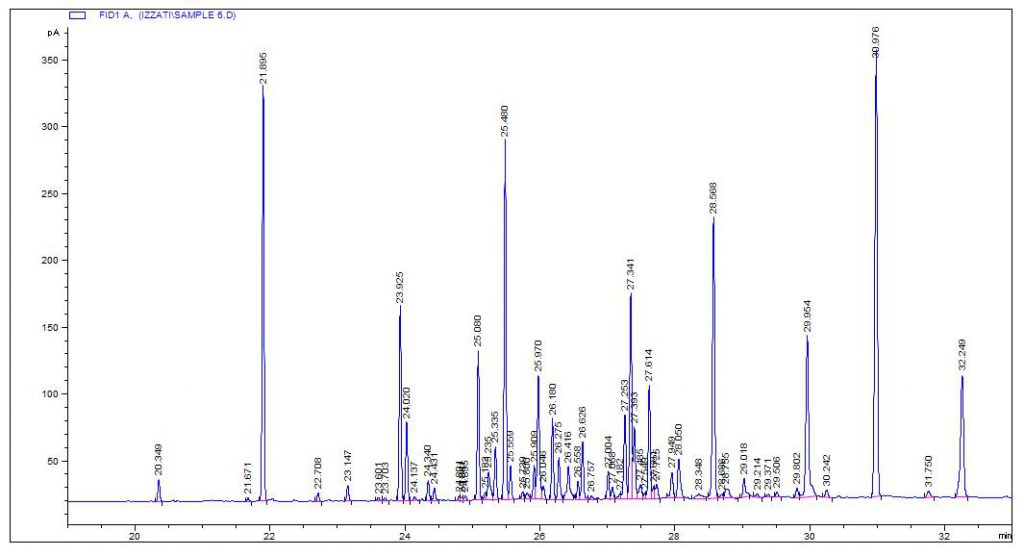
October 11, 2019, by Lisa Chin
My journey so far in Lancaster, UK – 2nd part
This post is contributed by Nur Izzati Ridzuan, recipient of the International Research Collaboration Award 2019 and PhD student from the School of Biosciences.
It is the second part of a series of posts about her research attachment with the Plant-Soil Interaction Group in Centre for Ecology and Hydrology based at Lancaster University, UK.
1st part of my journey in Lancaster, UK
Picking up from where I left off, I was taught on how to use the gas chromatography with flame ionization detection (GC-FID). It was exciting to see the peaks generated but the work doesn’t end there as the data collected needs to be further analysed. In short, identification of phospholipid fatty acids (PLFAs) was achieved using relative retention times and there was a formula involved for the calculation of each phospholipid. Besides, I was introduced to R, which is one of the popular platforms for statistical programming. This gave me a different angle on how to statistically analyse my PLFAs data and how to present them.
By using the elemental analyser machine, I was able to determine the carbon (C) and nitrogen (N) content and subsequently the C/N ratio of my soil samples. The samples were placed in the autoloader and were automatically dropped into the combustion furnace. Combustion converted C to carbon dioxide (CO2) and N to nitrogen gas (N2). The detection system will detect the gases as they were released. In addition, I was given a chance to try out Palintest Complete Soil Kit that the Centre for Ecology and Hydrology (CEH) has recently bought in which the kit is sufficiently portable to be used in the field. This kit provides simple yet reliable test protocols for macronutrients (soil pH, N, P, K), micronutrients and trace minerals including sulphur, manganese and magnesium. This provided me with a new insight on conducting soil nutrient analysis in the field for future works.
Aside from lab works, every Tuesday morning, for approximately 30-45 minutes, there will be a coffee session in which all the group members gather. This is an informal meeting so that we can catch up with one another and have our caffeine boost. I managed to explore Lancaster further in which I visited the Cottage Museum and Lancaster City Museum, walked along the Lancaster Canal and Fairfield Nature Reserve to see its fabulous flora and fauna (especially the White Park cow that is an ancient and endangered breed of cattle). At Williamson Park, it is the home of the iconic Ashton Memorial, known as the ‘Taj Mahal of the North’ and also as ‘England’s grandest folly’. Located on the highest ground in the Lancaster area, the building looked so majestic and the view was breathtaking in which the Lancaster town, the River Lune and the Morecambe Bay can be seen from here.
Other than that, now I understand why British people are so obsessed with the weather as it can be unpredictable at times in which it can change drastically in a day. It can be sunny one day and gloomy and wet for several days after. Therefore, I will check the weather forecast at least once a day especially in the morning to decide on whether to wear thicker clothes or to bring an umbrella or not. In my last week here (early October), the weather has become very cold and the lowest temperature recorded was 3°C.
I was also fortunate to take part in the Diwali celebration in which all the staff and students of CEH and Lancaster Environment Centre (LEC) came together. Though I am no stranger to Diwali (or Deepavali) festivals, it was an unforgettable moment to experience it in the UK. The food was specially prepared by the Indian staff and there was also a Bollywood dance performance. This was also a good time for me to mingle around and established new connections. The Diwali celebration marked the end of my 5-week attachment at Lancaster University.
I would like to express my gratitude to Prof Niall McNamara and his team for the skills and techniques in soil analysis, my supervisor Dr Christina Supramaniam for the support and not to forget Prof Deborah Hall and the Graduate School for this opportunity. Last but not least, the Malaysian students at Lancaster University who made me feel at home. Though it was only a short attachment, this was truly a wonderful experience for me.
Feature image: Plant-Soil Interaction Group (CEH)
About the award
The International Research Collaboration Award (IRCA) is a competitive award to a funded visit, of up to two months duration, with a maximum of MYR 15,000, at a host organisation anywhere in the world that may act as a collaborator for a research project. The host organisation can be any type of organisation (i.e. a university, a research institute, a business, a government department, a charity, a non-governmental organisation).
This year, we offered two doctoral training awards to promote research mobility by enabling the award recipients to undertake a research visit to a leading international research institution of their choice.
About the award recipient
Nur Izzati Ridzuan was announced as one of the winners of the IRCA by Professor Deborah Hall, Vice-Provost of Research and Knowledge Exchange, on 15 July 2019.
Contact us
For any queries or more information, please email us at graduateschool@nottingham.edu.my.
-
Post a comment




